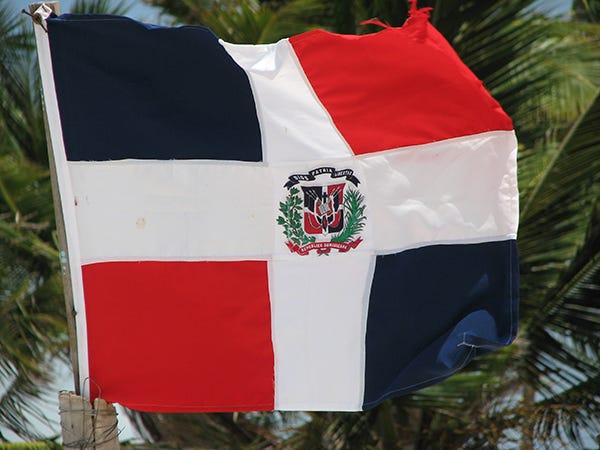Flying the flag 🪡 🏳️⚧️ 🗺
The women who nailed their colours to the mast.
Today we’re stitching together the history of women who have designed national flags, sewn symbols of solidarity and pride, and hoisted hope for their communities.
Betsy Ross and Mary Young Pickersgill
The tale of how Betsy Ross sewed – and subtly redesigned – the very first American flag is one that many US patriots want to believe, but historians can’t find many facts to back up the story. In 1776, during the American Revolutionary War, legend has it that she was asked to make a flag by George Washington and two men from a congressional committee. She agreed, but apparently suggested using five-pointed stars instead of their preferred six-pointers, because they would be easier for her to cut out.
And so, the stars (in a circle formation back then) and stripes came to life thanks to this Pennsylvanian seamstress. It wasn’t until almost a century later that her grandson shared this version of events, and it captured the hearts of the American press and people, despite little evidence to prove it actually happened. However, another seamstress, Mary Young Pickersgill, definitely did put together a piece of American history when she was commissioned to make the massive Great Garrison Flag in 1813, better known as the Star-Spangled Banner. It inspired the national anthem of the same name.
María Trinidad Sánchez, Concepción Bona, Isabel Sosa and María de Jesús Pina
Though the concepts for the flag of the Dominican Republic were thought up by revolutionary Juan Pablo Darte, it was María Trinidad Sánchez, Concepción Bona, Isabel Sosa and María de Jesús Pina who brought his ideas to fruition. Using red fabric to symbolise the blood that had been shed in battle, blue to represent the sky and God, and white for peace, they created the flag that was raised for the first time on 27th February, 1844, the day independence was declared.
One of the women, freedom fighter María Trinidad Sánchez – who has a province of the Dominican Republic named in her honour – was a courier during the Dominican War of Independence. She was the first woman to be executed by President Pedro Santana when she refused to reveal the names of her fellow rebels.
Annie Dorrington
Successful watercolour wildflower painter Annie Dorrington entered a competition to come up with the new flag of Australia in 1901. She used a pseudonym, Ahasuerus, and submitted a design that, like many of the 32,823 entries, combined the Union Flag and the stars of the Southern Cross constellation (one sadly unsuccessful drawing by another entrant featured Australian animals playing cricket, which – no offence to Annie – would have been our choice). Five very similar flags were picked as the joint winners, and Annie’s was among them. She was the only woman on the list, and shared the £200 prize money with a teenage apprentice optician, a schoolboy, an architect and a ship’s officer. A version of their combined design still flies as the flag of Australia to this day.
Monica Helms
Monica Helms designed the trans pride flag in 1999. She had the idea after chatting to her friend Michael Page, creator of the bisexual flag, and he advised her to go for a simple design in order to keep costs low – the more stitches required, the more expensive the flag. The pink and blue she chose speak for themselves; the white represents intersex, gender neutral or transitioning members of the trans community. Monica made the flag so that the pattern works whichever way you fly it – symbolising, she says, “finding correctness in our lives.” She debuted it at Phoenix Pride the following year, and the original is now in the Smithsonian. Her flag has since been turned into an emoji, and is being planted on several notable peaks across the globe by trans climber Erin Parisi.
Susan Karike Huhume
In 1971, a nationwide competition launched in Papua New Guinea’s schools to help decide the colours of its future flag. When 15-year-old Susan Karike saw it, she wasn’t at all impressed with the proposed flag, designed by Australian artist Hal Holman, so she didn’t just change its colours – she redesigned the whole thing. She scrapped the original tricolour, swapping its bands of blue, yellow and green for a diagonal composition of black, red and gold, colours that were more in keeping with the traditions and tribes of her country. A couple of weeks later, the drawing in her exercise book was formally chosen as the flag of Papua New Guinea.
Astrid Båhl
Sápmi is a vast cultural region that’s home to the Sámi people. Geographically, it spans several countries – Norway, Sweden, Finland and Russia – so the Sámi flag is a significant symbol of togetherness and identity that’s flown across a huge area. An unofficial flag was designed in the 1960s, but it wasn’t until 1986 that Coastal Sámi artist Astrid Båhl used it to form the basis of her initial sketches for the first official Sámi flag. The colours are said to be inspired by traditional clothing, and the circle represents both the sun and the moon, a motif often found on shamanic drums.
In 2016, the Eurovision Song Contest caused controversy when organisers said the flag couldn’t be waved by audience members when Sámi singer-songwriter Agnete Johnsen represented Norway that year. After a backlash, they eventually reversed their decision – and it was definitely the most beautiful flag of the competition.
This week, Sian has been eating snickerdoodle cookies and Laura has been searching for prawn cocktail Wotsits. Like our new look? Buy us a cuppa.









